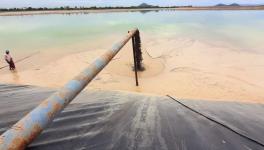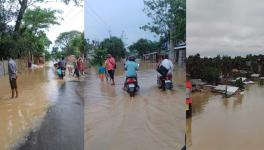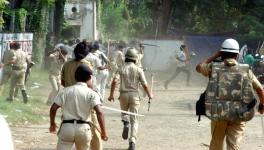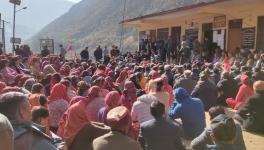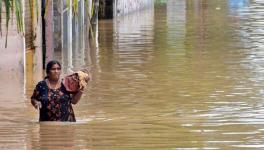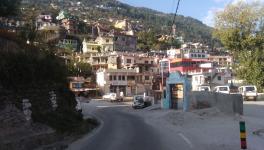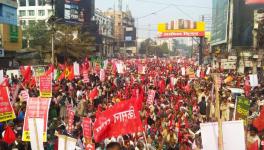Uttrakhand: Local Agitations And Disasters Hit Hard Already Delayed Yamuna Dam Project
Prime Minister Narendra Modi in the first week of December inaugurated the 120 MW Vyasi Hydro Electric Project (HEP), the first run of the river project on the main Yamuna river basin in Dehradun district of Uttarakhand. This is being seen in the context of the upcoming Assembly polls here as the project is otherwise not ready for power generation and the affected people of the area whose land had been acquired are still protesting for the promised fertile land in exchange and the monetary compensation. Environmentalists are also raising questions on the viability of the project, alluding to the high frequency of natural disasters occurring in the state in recent years.
The Vyasi HEP is a big project being built on the main stem of the Yamuna river in the Himalayan region. The run of the river’ project was originally part of the 420 MW Lakhwar Vyasi Multipurpose Project. The Lakhwar Dam is proposed some five kilometres upstream from the Vyasi HEP head. Later Lakhwar project, which is under legal scrutiny before the National Green Tribunal, was separated and the government wrapped up mandatory public hearings in September-October 2020 without following the due process such as information sharing or public hearing amid the COVID-19 pandemic.
Local people of Lohari village in the Vikasnagar tehsil are agitating for a long time for not getting land promised for rehabilitation and justified compensation amount for their village land acquired for the project.
Dinesh Tomar, secretary Yamuna Ghati (Lakhwar-Vyasi) Bandh Prabhavit Samiti told NewsClick, “The government has acquired 16.5 hectares of land for the project, which includes the land of our entire village and, chunks of a few nearby villages. Since the state government has been acquiring land piecemeal since 1970, many villagers were forced to accept paltry compensation before the enactment of the Right to Fair Compensation and Transparency in Land Acquisition, Rehabilitation and Resettlement Act, 2013. Now some additional amount has been given to pacify them, but that is not adequate.”
He said, the state government had also approved a proposal of allotting fertile land at Resham Bagh area of Vikasnagar tehsil for resettlement of locals of Lohari village in January 2017, but the government retracted in July this year. This was a major shock for the villagers, who have been agitating since then demanding a rollback of the recent decision.
“Vyasi HEP is being projected as a successful development project in the interest of people for ensuing the state Assembly election. This is the reason the project proponents got it inaugurated by the Prime Minister,” Rawat said. “Government is trying to quell our protest. Seventeen villagers were locked up in jail for five days on the charges of obstructing the work at the construction site on October 4. But we would not give up and continue fighting for our rights.”
Environmentalists are also expressing their reservations about building the project in a disaster-prone area.
Manoj Misra, head of Yamuna Jiye Abhiyan told NewsClick, “Vyasi dam at 80 plus metre height is relatively lesser of the two HEP 'devils' planned on the Yamuna system in Uttarakhand. The other is a 204 metres high dam at Lakhwar. It began as a combined project called Lakhwar-Vyasi which later were bifurcated. Vyasi dam is currently under construction. At the lower height with a run of river mechanism of power generation, it might not have a big reservoir unlike Lakhwar, but its adverse impacts on Yamuna biodiversity would be no less. Mahseer, the most important fish in these waters would obviously lose its habitat for all time, water flow in the river would become erratic, determined by the needs of power generation and sediment flow impeded. “
It is also well known that flash floods have been damaging under construction hydro projects across Himalayan states and flood disasters are also on the increase in the region due to the wrong operation of hydel projects.
A series of cloud burst incidents caused widespread destruction in the month of August over Binhar range in Pacchawadoon and Musooorie hills dividing Ganga and Yamuna basins in Dehradun district. The resultant deluge also affected Vyasi Vyasi HEP, thus exposing the very fact that the project is unprepared to cope with the existing and emerging disasters. The region is susceptible to cloudbursts, flash floods and recurrent landslide incidents.
Bhim Singh Rawat, an associate coordinator with South Asia Network on Dams Rivers and People said, “The region is susceptible to cloudburst, flash floods and recurrent landslide incidents. Above that, the careless handling of muck generated during the construction of 2.7 kilometres long, 7-metre dia tunnel in last eight years has added to the woes of local people and Yamuna river.”
The dumps are so close to the river that construction debris keeps spilling into the river, more so during Monsoon which has raised the river level. The prevailing situation can trigger more flash floods in future.”
He further explained, “There have been reports of an increase in landslide instances due to the construction activities as well as raising of the river bed due to faulty dumping of the overburden and construction debris close to the river water edge. The reports of the use of poor quality construction material also puts a question mark on the stability and future of the structure.”
He took a jibe at the measures taken such as retaining wall, wire crate (gabion box) wall which has become a ritualistic work primarily just before the monsoon season to prevent landslides proving useless. “A whooping sum of Rs 40 lakh which the Uttarakhand Jal Vidyut Nigam Limited (UJVNL) spent on geo jute and hydroseeding (grass slope protection) work at Hathiyari muck dumping yard turned out to be a wastage of public money,” Rawat said.
The project advocates often argue Vyasi HEP is located about 200 kilometres away from the glacial zone of Yamuna hence it’s in a relatively safe area. However, just in the past decade, there have been devastating floods in the Himalayan segment of the Yamuna basin in 2010, 2013, 2014, 2016 and 2019. With it being the first major dam on the Yamuna, the project must be prepared to face such a deluge taking place there periodically.
Rajiv Agarwal, executive director, Vyasi HEP, UJVNL responded to all these related queries. He said that fortunately the disaster just impacted outside the project boundary wall without harming the project site from inside during the August cloud burst incident.
As the project has been under construction for so many years, still nothing was done to install Early Warning System (EWS) or earthquake sensors to prepare for any disaster incidents. To this, he said, “We are not installing EWS but certainly coming up with a monitoring system to gauge the water level in the reservoir discharged or released so that in an alarming situation, local villagers can be alerted with the sirens.”
To avert landslides damaging the project site, he said that the only way out is the proper maintenance of the drainage system in the project area reasoning that any pent up muck in drainage can lead to landslides.
The project is also vulnerable to earthquakes as the terrain falls in seismic zone IV. He said, UJVNL has contacted IIT, Roorkee to provide effective earthquake sensors.
With regard to the ongoing agitation of locals, he said that the matter of allotment of land is to be handled by the state government, not UJVNL. However, Agarwal added that it would be for the first time in Uttarakhand that a provision of an additional ex gratia payment has been made to give more compensation to the residents and farmers whom a sum of compensation was already given over acquisition of their land.
UJVNL started working on Vyasi HEP early in 2014 with an estimated budget of Rs 950 crore and a commissioning target by December 2018. The current projected completion date as per the Central Electricity Authority figures is 2022-23. The completion of the project has already been delayed by over four years while construction cost has escalated to Rs 1,777.30 crore. As per CEA, the project would likely be commissioned by April 2022.
Agarwal said the project got delayed due to a shortage of manpower during COVID-19 restrictions in past two years, but it has picked up momentum now.
Manoj Misra is of the opinion that whether the project shall deliver the benefits as claimed in its benefit: cost ratio is anybody's guess since most HEPs in the land are underperforming. In the Himalayan belt, the influence of climate change is also an unknown determinant which this and similar projects have not been assessed for.
As usual amid cost escalation, delays, looming geological, climatic threats, norms violations and social injustice, the tall claims of the hydro project developers continue to be contradicted by the ground realities.
Get the latest reports & analysis with people's perspective on Protests, movements & deep analytical videos, discussions of the current affairs in your Telegram app. Subscribe to NewsClick's Telegram channel & get Real-Time updates on stories, as they get published on our website.









